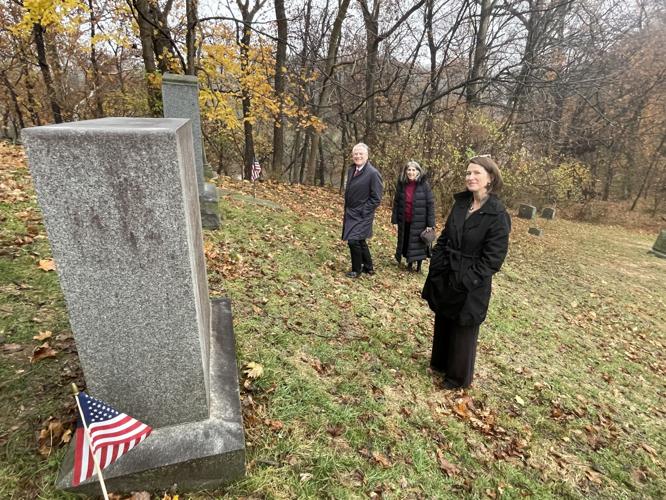When local historian Marion Wallace Reninger composed a booklet of “Famous Women of Lancaster County, Pennsylvania’’ in 1961, she included Ann Wood Henry.
Local historian John W.W. Loose listed Henry in “Meet a Dozen of Lancaster’s Most Distinguished Daughters’’ in the Journal of the Lancaster County Historical Society in 2000.
The next time someone ranks the best-known women of Lancaster, Henry (1732-1799) is bound to be among them. The primary reason is she was the first woman in Lancaster County and Pennsylvania to hold public office. She was county treasurer.
There are other reasons. Speakers mentioned many of them during a ceremony last Sunday near her grave site. The Henry memorial stands on ground sloping toward the Conestoga River in Greenwood Cemetery in southeast Lancaster.
“We’re here to commemorate an extraordinary gal who obviously was way ahead of her time,’’ said Carolyn Holt, president of the Lancaster/Dauphin/York Committee of the National Society of Colonial Dames of America.
The Dames, who trace their individual lineage to an ancestor who lived in this country in the colonial era, in 1953 dedicated a bronze plaque to Henry and placed it on the old Lancaster Moravian Church at West Orange and Market streets.
When the building was razed in 1967, the plaque was removed and taken to the historical society on President Avenue. The Moravian graves in a cemetery north of the church, where the Lancaster Post Office now stands, had been moved to Greenwood in 1917.
(Here is an opportunity to correct a two-decade-old error. The Scribbler column of Dec. 30, 2003, claimed that “Mrs. Henry’s plaque apparently was destroyed with the building.’’ Not so.)
The Colonial Dames thought it would be fitting to move the preserved plaque to the graveyard at Greenwood. The historical society agreed. So the plaque is now bolted to the reverse of a tombstone inscribed to Ann, her husband William and one of their sons.
At the recent ceremony, Tom Ryan, president and CEO of LancasterHistory, thanked Ann Henry for her public service. He said she “blazed an enviable trail for others to follow.’’
That refers to the fact that, following William Henry’s death in 1786, his wife not only completed his term as county treasurer but, because of her unusual skill in the post, was appointed to a full four-year term by the Pennsylvania Supreme Council.
Accolades to Ann Henry generally follow a description of her husband’s accomplishments. Tom Ryan chose not to dwell on those — inventor, gunsmith, soldier member of the Continental Congress and so on — but to emphasize the home life of William and Ann Henry.
The Henrys lived in a house that stood at what is now the southeast corner of Central Market. (A plaque just above eye level on that building marks the spot.) “It must have been a very, very busy place,’’ Ryan said of that house.
The Henrys had 13 children (six of whom died in infancy) and temporarily hosted an array of colonial leaders, including the painter Benjamin West; the “Penman of the Revolution’’ Thomas Paine; and David Rittenhouse, the scientist and acting state treasurer.
Ann Henry played gracious hostess to them all (except Paine, whom she reviled for his atheism and slovenly lifestyle) and she faithfully nursed her husband during the final months of his life. Then she diligently handled the county’s financial affairs.
Jack Brubaker, retired from the LNP staff, writes “The Scribbler’’ column every Sunday. He welcomes comments and contributions at scribblerlnp@gmail.com.





